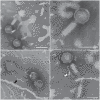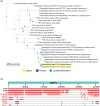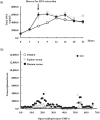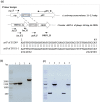Increased sensitivity of Aggregatibacter actinomycetemcomitans to human serum is mediated by induction of a bacteriophage
- PMID: 35833243
- PMCID: PMC10087258
- DOI: 10.1111/omi.12378
Increased sensitivity of Aggregatibacter actinomycetemcomitans to human serum is mediated by induction of a bacteriophage
Abstract
Aggregatibacter actinomycetemcomitans, a Gram-negative oral pathobiont causing aggressive periodontitis and systemic infections, demonstrates serum resistance. We have identified a dsDNA-tailed bacteriophage, S1249, which was found to convert from this microorganism inducible by human serum into a lytic state to kill the bacterium. This phage demonstrated active transcripts when exposed to human serum: 20% of genes were upregulated more than 10-fold, and 45% of them were upregulated 5-10-fold when the bacterium was grown in the presence of human serum compared to without the presence of human serum. Transcriptional activation when grown in equine serum was less pronounced. This phage demonstrated a tail with inner rigid tubes and an outer contractile sheath, features of Myoviridae spp. Further characterization revealed that the lysogenized integration of the phage in the chromosome of A. actinomycetemcomitans occurred between the genes encoding cold-shock DNA-binding domain-containing protein (csp) and glutamyl-tRNA synthetase (gltX). Both phage DNA integrated lysogeny and nonintegrated pseudolysogeny were identified in the infected bacterium. A newly generated, lysogenized strain using this phage displayed similar attributes, including 63% growth inhibition compared to its isogenic phage-free strain when in the presence of human serum. Our data suggest that bacteriophage S1249 can be induced in the presence of human serum and enters the lytic cycle, which reduces the viability of infected bacteria in vivo.
Keywords: Myoviridae; bacteriophages; gram-negative periodontal pathobionts; human serum; lytic cycle; pseudolysogeny.
© 2022 The Authors. Molecular Oral Microbiology published by John Wiley & Sons Ltd.
Conflict of interest statement
The authors declare no conflict of interest.
Figures







Similar articles
-
Human Serum Mediated Bacteriophage Life Cycle Switch in Aggregatibacter actinomycetemcomitans Is Linked to Pyruvate Dehydrogenase Complex.Life (Basel). 2023 Feb 3;13(2):436. doi: 10.3390/life13020436. Life (Basel). 2023. PMID: 36836793 Free PMC article.
-
Temperate bacteriophages are common among Actinobacillus actinomycetemcomitans isolates from periodontal pockets.J Periodontal Res. 1995 Nov;30(6):418-25. doi: 10.1111/j.1600-0765.1995.tb01296.x. J Periodontal Res. 1995. PMID: 8544106
-
Presence of bacteriophage Aa phi 23 correlates with the population genetic structure of Actinobacillus actinomycetemcomitans.Eur J Oral Sci. 1997 Feb;105(1):2-8. doi: 10.1111/j.1600-0722.1997.tb00173.x. Eur J Oral Sci. 1997. PMID: 9085022
-
Pseudolysogeny.Adv Virus Res. 2012;82:339-49. doi: 10.1016/B978-0-12-394621-8.00019-4. Adv Virus Res. 2012. PMID: 22420857 Review.
-
Coevolution of bacteria and their viruses.Folia Microbiol (Praha). 2013 May;58(3):177-86. doi: 10.1007/s12223-012-0195-5. Epub 2012 Sep 21. Folia Microbiol (Praha). 2013. PMID: 22993102 Review.
Cited by
-
Human Serum Mediated Bacteriophage Life Cycle Switch in Aggregatibacter actinomycetemcomitans Is Linked to Pyruvate Dehydrogenase Complex.Life (Basel). 2023 Feb 3;13(2):436. doi: 10.3390/life13020436. Life (Basel). 2023. PMID: 36836793 Free PMC article.
-
The potential use of bacteriophages as antibacterial agents in dental infection.Virol J. 2024 Oct 18;21(1):258. doi: 10.1186/s12985-024-02510-y. Virol J. 2024. PMID: 39425223 Free PMC article. Review.
-
Mitochondrial DNA Missense Mutations ChrMT: 8981A > G and ChrMT: 6268C > T Identified in a Caucasian Female with Myalgic Encephalomyelitis/Chronic Fatigue Syndrome (ME/CFS) Triggered by the Epstein-Barr Virus.Case Rep Genet. 2024 May 9;2024:6475425. doi: 10.1155/2024/6475425. eCollection 2024. Case Rep Genet. 2024. PMID: 38756740 Free PMC article.
-
A review and new perspective on oral bacteriophages: manifestations in the ecology of oral diseases.J Oral Microbiol. 2024 May 1;16(1):2344272. doi: 10.1080/20002297.2024.2344272. eCollection 2024. J Oral Microbiol. 2024. PMID: 38698893 Free PMC article. Review.
-
Periodontitis: etiology, conventional treatments, and emerging bacteriophage and predatory bacteria therapies.Front Microbiol. 2024 Sep 26;15:1469414. doi: 10.3389/fmicb.2024.1469414. eCollection 2024. Front Microbiol. 2024. PMID: 39391608 Free PMC article. Review.
References
-
- Akrivopoulou, C. , Green, I. M. , Donos, N. , Nair, S. P. , & Ready, D. (2017). Aggregatibacter actinomycetemcomitans serotype prevalence and antibiotic resistance in a UK population with periodontitis. Journal of Global Antimicrobial Resistance, 10, 54–58. - PubMed
-
- Anton‐Vazquez, V. , Dworakowski, R. , Cannata, A. , Amin‐Youssef, G. , Gunning, M. , Papachristidis, A. , MacCarthy, P. , Baghai, M. , Deshpande, R. , Khan, H. , Byrne, J. , & Fife, A. (2022). 16S rDNA PCR for the aetiological diagnosis of culture‐negative infective endocarditis. Infection, 50(1), 243–249. 10.1007/s15010-021-01690-x - DOI - PubMed
-
- Ardila, C. M. , & Bedoya‐García, J. A. (2020). Antimicrobial resistance of Aggregatibacter actinomycetemcomitans, Porphyromonas gingivalis and Tannerella forsythia in periodontitis patients. Journal of Global Antimicrobial Resistance, 22, 215–218. - PubMed
-
- Asakawa, R. , Komatsuzawa, H. , Kawai, T. , Yamada, S. , Goncalves, R. B. , Izumi, S. , Fujiwara, T. , Nakano, Y. , Suzuki, N. , Uchida, Y. , Ouhara, K. , Shiba, H. , Taubman, M. A. , Kurihara, H. , & Sugai, M. (2003). Outer membrane protein 100, a versatile virulence factor of Actinobacillus actinomycetemcomitans . Molecular Microbiology, 50(4), 1125–1139. 10.1046/j.1365-2958.2003.03748.x - DOI - PubMed
Publication types
MeSH terms
Grants and funding
LinkOut - more resources
Full Text Sources
Miscellaneous

